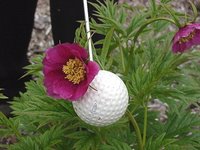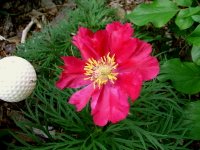______________________________
 This was one of the first species of peony that I came to grow, from seed obtained through the seed exchange of the Devonian Botanical Garden near Edmonton Alberta. In my early ignorance of all the rest of the species, I used to think it was one of the
This was one of the first species of peony that I came to grow, from seed obtained through the seed exchange of the Devonian Botanical Garden near Edmonton Alberta. In my early ignorance of all the rest of the species, I used to think it was one of the  earliest of peonies to bloom. Now of course we all know better, after writing and reading at this weblog.
earliest of peonies to bloom. Now of course we all know better, after writing and reading at this weblog.Although I've been growing it for over a decade it is only recently that I started to
 see variations in flower colour, in plants grown from seed collected off my plants and in seed obtained from elsewhere.
see variations in flower colour, in plants grown from seed collected off my plants and in seed obtained from elsewhere.Common name: Veitch's Peony. Paeonia veitchii has been an easy and low
 maintenance plant for me, responding well to neglect. Sturdy stems produce an almost dome-shaped bush form by the age of 6 or so; height: 2-3 ft.
maintenance plant for me, responding well to neglect. Sturdy stems produce an almost dome-shaped bush form by the age of 6 or so; height: 2-3 ft.All the species we've looked at up to now
 have only one flower per mature stem. Veitchii however has side-buds, some of which do not mature but usually each stem will put out 3 to 5 flowers. This means a longer bloom period, 2 to 3 weeks as opposed to about 1 week for the earlier
have only one flower per mature stem. Veitchii however has side-buds, some of which do not mature but usually each stem will put out 3 to 5 flowers. This means a longer bloom period, 2 to 3 weeks as opposed to about 1 week for the earlier  species.
species.It's native to NW China (in the provinces of Gansu, Sichuan and Shensi), where it grows in subalpine meadows and scrub, and to mountain grasslands. In my gardens it is quite adaptable, growing decently in all my bed sites, although flowering less in the woodland bed and remaining shorter more compact in the open field than it is in partial shade.
Some plants have foliage with an interesting etched-like appearance to the veining, while that of others appears smooth. The foliage maintains a great appearance right up to the first frost with no ornamentally interesting colour-change.
 The deep red flower here is from seed obtained from a seed exchange as the "late-flowering form" of P veitchii; no mention of any departure from the usual pink flowers. Well, it chooses to flower at the same time
The deep red flower here is from seed obtained from a seed exchange as the "late-flowering form" of P veitchii; no mention of any departure from the usual pink flowers. Well, it chooses to flower at the same time  as all my other veitchii's (starting 31 May this year) but has this intensely deep red bud that any rose would be proud to have, and flowers that age to crimson. An exciting variant!
as all my other veitchii's (starting 31 May this year) but has this intensely deep red bud that any rose would be proud to have, and flowers that age to crimson. An exciting variant!
These last two photos are of a probable hybrid grown from seed from a seed exchange. The foliage is incredibly finely-cut, almost as fine as tenuifolia. The flower is a very good red with a slight bluish tinge.


1 comment:
Great plants - nice variation too. Including white, as well as the red one.
The fine leaved one must surely be a tenuifolia hybrid, but interestingly it did not bring that plant's true red colour across - well maybe some influence, but there is some evidence of the mauve pink of the veitchii parent in those flowers.
The really dark red one seems to have normal foliage. I would have expected some tenuifolia influence in it, from the colour.
A good blog entry.
Post a Comment